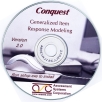產品目錄
產品目錄
Showing 4 of 4 results
ASC XCalibre 項目反應理論(IRT)分析軟體
Xcalibre 在對評估數據進行項目反應理論(IRT)分析的軟體中居於領先地位。Xcalibre 使用4個二分(dichotomous)和5個多分類(polytomous) IRT模型來調整您的檢驗,並可以產生專業匯總分析報告,包括內嵌圖形和表格來幫助數據解釋。Xcalibre 4是目前最綜合的IRT軟體,完全不需要執行DOS命令!
XCALIBRE 使用邊際最大概似法估計項目參數(Item parameter estimation),此法的優點是可以改進當測試的數目很少時或短缺時。XCALIBRE依然可以估計2-3參數IRT模型,非常適合大量且有希疏性的不完整資料估計。
License介紹
Xcalibre 4 licenses are determined by the use of the program:
Student research license - Proof of student status required.
Academic - The program will be used at an accredited college or university for research or teaching purposes only.
Government/Non-profit - The program will be used at a governmental or a non-profit organization, or by a school district or college or university for analyzing the data from its testing programs. The use of the program must also be non-profit; that is, if the organization is non-profit but conducts consulting activities for other organizations, the use is commercial.
Commercial - The program will be used for commercial purposes, for example, in the course of consulting in test development and psychometrics.
ConQuest Version 是一種電腦程式安裝項目反應(Rasch)和潛在回歸模型。它提供了一系列全面,靈活的項目反應模型(IRM)的分析,讓他們檢查的業績評估的屬性,傳統的評估和評價尺度。ConQuest 還提供了更廣泛的測量和研究界最先進的最新心理測量方法多方面的項目反應模式,多層面的項目反應模型,回歸模型和圖紙潛在可能的值。
ACER ConQuest 5 新版特色
ACER ConQuest 5 is a computer program for fitting both unidimensional and multidimensional item response and latent regression models. It provides data analysis based on a comprehensive and flexible range of item response models (IRM), allowing examination of the properties of performance assessments, traditional assessments and rating scales. ACER ConQuest 5 also offers wider measurement and research community analysis procedures based on the most up-to-date psychometric methods of multifaceted item response models, multidimensional item response models, latent regression models and drawing plausible values.
ACER ConQuest Version 5 software includes:
A choice of marginal maximum likelihood, joint maximum likelihood or Bayesian Markov Chain Monte Carlo (MCMC) estimation
With MCMC estimation, the ability to add random effects to the item response model
Implementation of multidimensional and multifaceted Bock model and generalised partial credit model (GPCM)
Estimation of the Bradley–Terry–Luce (BTL) model for pairwise comparisons
Direct reading of SPSS data files and CSV text files
Output of results to SPSS, EXCEL, CSV or other text files
A wide array of graphical outputs, including Wright maps, Wright predicted probability maps, likelihood plots and information maps
Person fit and residuals
Latent variable path modelling
Mantel-Haenszel DIF estimates
Powerful manipulation of matrix variables and control logic (if, while, do) for advanced modelling, including specifying custom design matrices or fitting iterative models.
Integration with R through the conquestr library
Advanced features, including the ability to impose new constraints on GPCM models, including imposing maximum and positive scores, as well as freely estimated variances through slope constraints.
產品規格
ACER ConQuest 5 is available with both a graphical user interface (GUI) and a simple command line, or console, interface. The software is available in Windows and Mac versions:
Windows: contains both the GUI and console versions for 32-bit and 64-bit Windows operating systems.
Mac: contains only the console version for the 64-bit Mac operating system. No GUI is available. ACER ConQuest for Windows can also be used on Macs running Windows.
ACER ConQuest 5 comes with a range of online resources and access to prompt email support.
項目反應理論 (Item Response Theory,簡稱IRT) 包括以下軟體:
BILOG-MG, IRTPRO, and PARSCALE for Windows
IRTPRO for Windows 特色:
◊ 試題反應理論(IRT)可以應用在以下分析
編製測驗(量表)
測驗等化
建立題庫
組合測驗
電腦化適性測驗
這些軟體可作為題目分析以及分數估計等方面的重要工具,並且在各個領域被廣泛應用。
介紹 IRTPRO
IRTPRO,這是一項在目前的技術尖端的產品。該方案已於微軟的 Windows平台的 Windows7,Vista和 XP操作系統上經過廣泛的測試。
IRTPRO 數值引擎的重要區塊已同時並行運行多個核心。
IRTPRO 發展得到了NIH的SBIR計劃合同HHSN-2612007-00013C 題為:
MEDPRO:開發項目反應理論成果和行為測量軟體。
Technical Description
IRTPRO imports data from a variety of statistical software packages as well as importing data from fixed format data (.fixed), comma-separated (.csv), tab-delimited (usually .txt), and Excel (.xls) files. Whatever the original format, the imported data are saved to an IRTPRO data file with extension .ssig that is displayed visually as a spreadsheet, similar in appearance to an Excel spreadsheet.
IRT models for which item calibration and scoring are implemented in IRTPRO are based on unidimensional and multidimensional [confirmatory factor analysis (CFA) or exploratory factor analysis (EFA)] versions of the following widely used response functions:
o Two-parameter logistic (2PL) [with which equality constraints includes the one-parameter logistic (1PL)
o Three-parameter logistic (3PL)
o Graded
o Generalized Partial Credit
o Nominal
Winsteps 是Windows 介面的軟體,用 Rasch-Model 的很多應用幫助,特別是在教育測試,看法調查和等級規模分析的區域內。
Rasch analysis是一種方法,能夠獲得客觀的、基本的、由隨機觀察有序類別的反應的線性措施(合格的標準誤差和質量控制符合統計)。Georg Rasch,丹麥數學家,於 1953年制定本辦法,分析了一系列的反應,閱讀測驗(Rasch G, Probabilistic Models for Some Intelligence and Attainment Tests, Chicago: MESA Press, 1992, withinstructive Foreword and Afterword by B.D. Wright)
在丹麥語Rasch發音類似英語單詞rash,在德國聽起來像英語raa-sch。德國發音,raa-sch,是為了避免誤解。人與項目總原始分數被用來估計線性措施。 Rasch模式條件下,這些措施是項目免費(項目分配免費)和人的自由(人分配免費)。因此,該措施相當於統計的項目-無論是哪個人(來自同一人口)進行了分析,對其中無論哪個項目(來自同一人口)進行了分析。分析數據的響應級別表明在何種程度上實現這些理想在任何特定的數據集。
在 Winsteps,Rasch模式實施包括Georg Rasch dichotomous, Andrich "rating scale",Masters "partial credit", Bradley-Terry "paired comparison",Glas "success model",Linacre "failure model"和most combinations of these models。其他如binomial trials和Poisson也可以分析anchoring (fixing)的結構,以符合反應的反應模型。 (如果您有特殊需要,請讓我們知道,Winsteps不斷增強。)
該估計方法是JMLE,“Joint Maximum Likelihood Estimation”,與初始值開始提供PROX是Normal Approximation Algorithm”。
系統需求
» Windows: Winsteps is 64-bit/32-bit software. It runs successfully under Windows 11, 10, 8, 7, Vista, but not Windows XP, 2000, ME, NT, 98, 95, 3.1.
For Windows XP and 32-bit-only Windows installations, Winsteps 4.8.2 is available. Purchase a standard Winsteps license, then request the earlier Winsteps version.
» Mac, Linux,Chrome OS: Winsteps runs under Windows installed on the target hardware using special-purpose software.
Please check compatibility by downloading and running the free student/evaluation/demo version, MINISTEP - same as Winsteps but limited to 25 items and 75 persons/cases.




